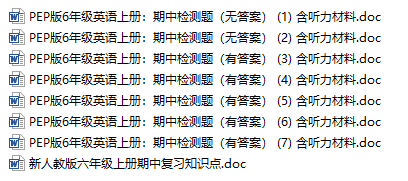PEP版6年级英语上册期中检测题期中复习知识点8套
期中复习知识点
重点单词和短语
四会单词: Unit 1Science科学, museum博物馆,post office邮局, bookstore书店,cinema电影院,hospital 医院,crossing十字路口,turn left 左拐,turn right右拐,go straight=walk straight直走,buy买, next to紧挨着/与……相邻,far from(离……远),near在……附近,behind(在……后面), in front of(在……前面)
Unit 2 on foot步行,by bus =take a bus 乘公交车,by bike骑自行车,by plane,乘飞机,by taxi, 乘出租车,by ship,乘船 ,by subway 乘地铁,by train乘火车,slow down 慢下来,stop 停, wait等,
Unit 3, visit one’s grandparents 看望祖(或外祖)父母 see a film 看电影take a trip 去旅行go to the supermarket 去超市this morning今天早上 this afternoon今天下午 this evening今天晚上 tonight在今晚 tomorrow明天 next week 下周dictionary 字(词)典comic book(儿童的)连环画册 word book 单词书postcard 明信片2·1·c·n·j·y
三会单词Unit 1 send 邮寄between…and… 在……和……之间, London Eye伦敦银,Thames 泰晤士河,finally终于,portion(食物的)一份,tasty美味的,stomach胃,astray走错方向 (p80) [Better to ask the way than go astray.问路总比迷路好。] 【来源:21·世纪·教育·网】
Unit 2 by ferry乘轮渡,Hooray!好极了!pay attention to注意 ,cross the road横穿马路 ,traffic lights交通信号灯,at home在家 , missed(miss的过去式)想念 , different,不同 ,chopsticks,筷子(复数),cross穿过,look right向右看,same 相同的,door门, look at朝……看 play with和……一起玩 , British 英国的,double-decker双层公共汽车, same相同的, airplane 飞机(p70)course(赛马比赛的)跑道(p80)[Horses for courses.知人善任。] 21·世纪*教育网
Unit 3,1、my weekend plan 我的周末计划 2 nature park 自然公园 3 look for 寻找 4 have an art lesson 上美术课 5 draw some picture 画一些画 6 Sounds 听起来 7 Have a good time 祝你开心 8 have to 不得不 后跟动词原形 9 do my homework 做我的家庭作业 10 go ice—skating 去滑冰 11 make a snowman 堆雪人 12 go for a picnic 去野餐 13 be going to = will 将要 (后跟动词原形)与表示将来的时间连用(tomorrow, tonight, next week, this morning,…) Be 动词包括:am ,is , are 口诀:I 用 am ,you 用 are ,is 跟着 he ,she ,it . we 和they 都 用 are 单数用is , 复数用 are 14 about 关于 15 space travel: 太空旅行 16 lots of 许多 后跟可数名词的复数和不可数名词 lots of books lots of water 17 why not :为什么不?后跟动词原形 18 let’s = let us 让我们 后跟动词原形 19 what about …?: 怎么样? 后跟动词ing 形式 what about reading (read) a comic book? 20 on + 星期几 :在星期几 21 half price 半价 22 family 家人 (复数) 做主语时:be 动词用are 23 get together 聚会 24 make mooncakes 做月饼 25 tell stories 讲故事 tell a story 讲一个故事 26 read a poem 朗读诗歌 27 how to swim 怎么游泳 28 learn to swim 学会游泳 29 learn by doing 在实践中学习 30 without 没有(介词) 后跟动词ing 形式 31 swimming pool 游泳池 32 try 尝试 33 easy 容易的 34 remember 记住35 soldier 军人(p70)36 think 思考 (p80)37speak说,讲(p80)【Think today and speak tomorrow.三思而后行。】www-2-1-cnjy-com
按要求写单词:
Unit 1hot(反义词)cold,cool(反义词)warm,too(同音词)to/two ,can not(缩写)can’t, right(反义词)left/wrong ,buy(同音词)by/bye sea(同音词)see, first(基数词)one ,four(序数词)fourth ,did (原形)do /does,three(序数词)third ,give(过去式)gave www.21-cn-jy.com
Unit 2 go (反义词)come, foot(复数)feet, child(复数)children ,early(反义词)late,slow(反义词)fast ,go (过去式)went,do(过去式) did ,do(第三人称单数) does。go(第三人称单数) goes。
重点句型分析
Unit 1
1.Where is the museum shop? 博物馆的商店在哪儿?
此问句是由特殊疑问词where 引导的一个特殊疑问句, where意为“在哪里,到哪里”,用来询问地点, 放在句子的开头。询问“某人或某物在哪里”的基本句型是:“ Where +is/are+ 主语?”,where is 后接名词或代词的单数形式,where are 后接名词或代词的复数形式。表示地点的词:museum博物馆, post office邮局, bookstore书店, cinema电影院, hospital医院restaurant餐馆bank银行bus stop公交车站lake湖library图书馆zoo动物园school学校park公园garden花园hotel旅馆21世纪教育网版权所有
- It’s near the door.在大门附近。
此句中near是表示位置的介词,意为“旁边,附近” , 其同义句是:It’s next to the door.它在门的旁边。表示位置的短语:next to the bookstore挨着书店near the hospital在医院附近near the post office在邮局附近over there 在那边on Dongfang Street在东方大街上in front of the school在学校前面
3.How can we get there? 我们怎么到那儿?
此句用来询问“怎样去某地”,后面直接跟地点。回答时,可以用“ Turn left, turn right, go straight.”等句来回答。21cnjy.com
同义句: 1.Can you tell me the way to+地点? 2.Where is the +地点? 21·cn·jy·com
3.Which is the way to +地点
- Turn left at the bookstore. Then turn right at the hospital. 到书店左转。然后到医院右转。
此句是指路的句型。常用到的句型有:turn left, 向左转turn right, 向右转go straight直着走。同时表示在某处的介词用at. 2-1-c-n-j-y
- Is the Thames far from here? No, it isn’t.泰晤士河离这里远吗?不,不远。 21*cnjy*com
此句是个be动词开头的一般疑问句, 其回答要用Yes.或No. 句中的far from意为“离……远”。反义词组为next to. 【来源:21cnj*y.co*m】
Unit 2
- How do you come to school?你(们)怎么来学校的?
此问句是由特殊疑问词how引导的特殊疑问句, 用于询问对方的出行方式。 回答时要根据具体情况作答。 21教育名师原创作品
表示地点的词:Germany德国 Munich慕尼黑 England英国 Australia澳大利亚 school学校 the park 公园the cinema电影院 the hospital医院 the post office邮局 the bus stop公共汽车站 home家
- Usually, I come on foot.=Usually, I walk.通常情况下,我步行来。21*cnjy*com
此句是对出行方式的回答句。 其中usually意为“通常”, 表示频率很大, on foot意为“步行”。 一般用by表示出行方式。 By后面一定要直接加交通工具的单数形式, 只有“小脚丫”foot与on 搭配, “步行”用on foot表示。 【出处:21教育名师】
- I must pay attention to the traffic lights.我必须注意交通信号灯。
must是情态动词,意为“必须”后面跟动词原形。 动作词组:wear a helmet戴头盔 pay attention to the traffic lights注意交通信号灯 look right向右看
- Don’t go at the red light! 别闯红灯!
此句是Don’t开头的否定祈使句, don’t后面跟动词原形。意为“不要做某事”。 动作词组:run跑 go at the red light闯红灯 touch the door触摸门
- We must look right before crossing the road.我们在横穿马路前必须看看右边。 【版权所有:21教育】
此句中must是情态动词, 意为“必须”后面跟动词原形, 在此句中before是一个介词, 而介词后面跟动词-ing形式。 6. So many pictures of bikes. 如此多的自行车照片。 pictures of bikes 自行车的照片 ……of…….. ……的……例如:the door of classroom .教室的门
- In the USA ,people on bikes must wear one.在美国骑自行车的人必须带头盔。
Unit 3
1 what are you going to do? 你打算做什么?
2 When are you going ? 你打算什么时候去?
3 Where are you going ? 你打算去哪里? 4 Who are you going with? 谁和你一起去? 5 How are you going to shanghai ? 你怎么去上海? 21教育网
What (什么) 对事情和物 提问 ;
Who(谁 ) 对人 提问
When (什么时候)对时间 提问 ;
Where (哪儿) 对地点 提问;
How(多么)对身体状况和交通方式提问





